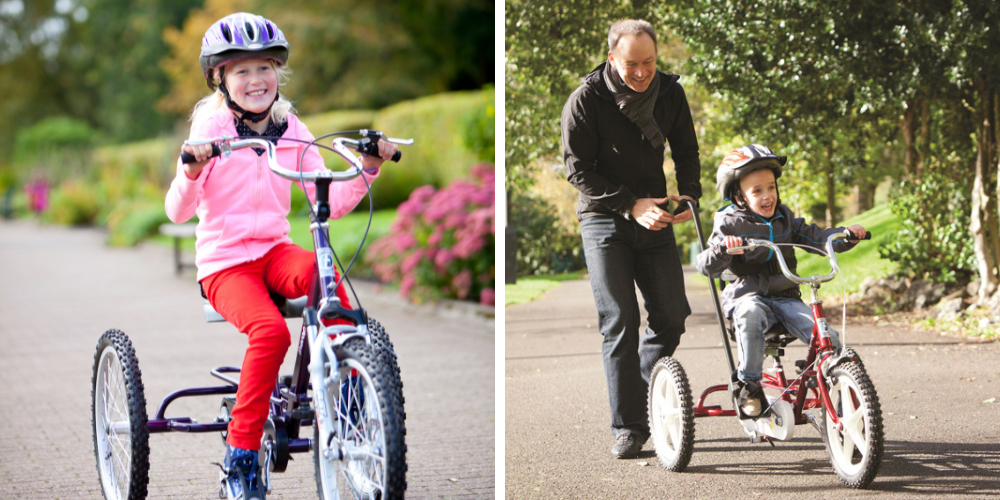A GUIDE TO SPECIALIST CYCLES & TRIKES
Learning to ride a bike is something that most of us do as young children. It’s a skill that’s passed down through the generations and it brings us hours of fun and freedom – the wind in our hair, fresh air on our faces, and happy times spent outside riding around with friends.
Although cycling is traditionally associated with two-wheeled bicycles, specialist bikes are becoming increasingly available and ever more popular, making cycling accessible to everyone, regardless of physical ability.
Here, we look at some of the different types of specialist cycles and accessories that are available on the market.
Types of Specialist Bike
Tricycles:
Specialist trikes are the most popular type of cycle available for those with disabilities. Not only are they fun to ride, but each trike is tailored to the rider’s specific needs. The clever frame design allows the seat position to be altered in relation to the foot pedals, and the handlebars can be adjusted to provide the rider with a comfortable and well-supported seating position.
Specialist trikes can be further tailored with a variety of positioning accessories (see more details below) providing even more comfort and support for the rider.
Companion cycles:
Companion cycles, as the name suggests, allow two people to cycle together. Both riders can be pedalling, or one can pedal and the other simply enjoys the ride.
Different models of companion cycle offer different seat configurations - side-by-side seats or one behind the other.
Quad cycles:
Quad cycles, which are fitted with four wheels, give a little extra stability than three-wheeled trikes. They are also smooth to ride, as the steering is light, and pedalling is easy.
Similarly to trikes, quad cycles can be tailored with a variety of positioning accessories, ensuring the correct level of support for riders, as well as additional comfort.
Positioning Accessories
To enable those with disabilities to enjoy cycling safely and comfortably, some additional support is often needed. A range of positioning accessories are available which can be easily attached or removed to a bike to provide the correct support for a specific rider.
Gears:
Specialist trikes and bikes can be fitted with either a fixed gear or an option drive gear.
A fixed gear enables the rider to pedal forwards and backwards - the wheels rotate as the pedals rotate. It’s a great way for riders to learn the relationship between pedalling and the movement of the bike.
The option drive gear allows the bike to be ridden in either fixed gear mode or freewheel mode, altered by a simple locking mechanism. This provides riders with flexibility to progress from a fixed to freewheel as they become more confident and advanced in their riding abilities.
Seats and saddles:
A range of seats are available to accommodate differing needs.
Traditional seat posts and saddles enable the height to be adjusted as the rider grows.
Contoured saddles are shaped to help improve trunk control and prevent sliding.
Seat posts and saddles with trunk support mounts allow additional back and hip supports to be attached.
Foot sandals:
Foot sandals provide riders with support throughout the full length of the foot. They prevent the feet rotating inwards or outwards, helping to ensure that good alignment is maintained, to enable an easier pedalling position. Foot sandals are available in a range of sizes.
Trunk supports:
A range of trunk supports are available which offer additional back, side, and front support. They are easily attached to the bike with mounts incorporated into the saddle.
Pelvic straps and supports:
The addition of a pelvic strap helps keep the pelvis securely in place and assists the rider in maintaining a comfortable seating position.
Lateral pelvic supports are also available which help keep the rider’s hips in a centralised position. They can be used in conjunction with a back support or on their own.
Leg calipers:
Leg calipers support the rider’s lower leg by way of a padded cuff which holds the leg firmly in place. They are used in conjunction with foot sandals and are available in a range of sizes.
Handlebars:
Specialist bikes can also be tailored with a choice of handlebar. Several different options are available which promote good body positioning and posture, and also help riders to maintain their grip.
Control poles and steering mechanisms:
Finally, a range of control poles and steering mechanisms are available which can be attached to the rear of specialist bikes and specialist trikes for support from parents and carers. Control poles enable the control of the brakes, whilst steering mechanisms enable parents/carers to help steer whilst walking behind the rider.
